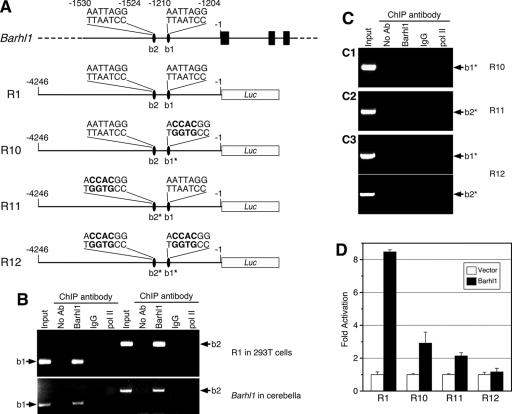FIG. 5.
Site-directed mutagenesis of both homeoprotein binding motifs abolishes Barhl1 binding to and autoactivation of the 4.2-kb 5′ promoter sequence. (A) Schematic illustration of the endogenous Barhl1 locus, the wild-type luciferase (Luc) reporter construct (R1) containing the Barhl1 5′ promoter sequence, and the derived single- and double-mutant constructs (R10 to R12). The black bars represent the three coding exons of Barhl1, and the ovals indicate the two putative Barhl1 binding sites (b1 and b2) in the promoter region. As indicated in boldface and with asterisks, the TAAT motif was mutated to GTGG in the b1 and/or b2 binding sites of R10 to R12. (B) Results from a ChIP assay showing in vivo binding of Barhl1 to the b1 and b2 homeoprotein binding motifs in the Barhl1 5′ promoter region. ChIP assays were carried out with chromatin DNA prepared from 293T cells cotransfected with the R1 promoter construct and a Barhl1 expression plasmid (upper panel) or from P10 mouse cerebella (lower panel). Immunoprecipitates were analyzed by PCR using primers flanking the b1 or b2 site. pol II, anti-RNA Pol II antibody; no Ab, no antibody. (C) Results from ChIP assays with chromatin DNA prepared from 293T cells cotransfected with a Barhl1 expression plasmid and the R10 (C1), R11 (C2), or R12 (C3) reporter construct. (D) Levels of activation of the luciferase activities of wild-type and mutant constructs by Barhl1. Each histogram represents the means ± SD of results from triplicate assays in a single experiment, and all experiments were repeated three times with similar results.

